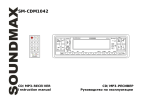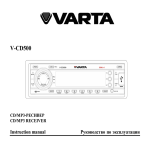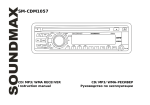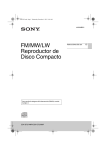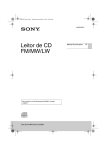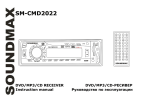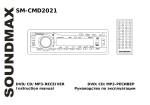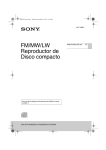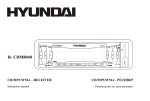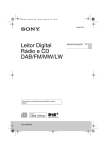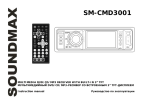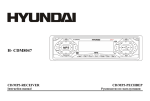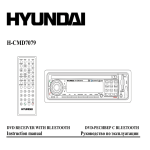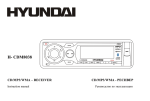Download SoundMax SM-CDM1040 User's Manual
Transcript
SM-CDM1040 EQ DISP SD MMC SM-CDM1040 BND LOUD AS/PS CD/MP3-RECEIVER Instruction manual MODE 1 SCN RPT SHF 2 3 4 REG 5 6 TA AF PTY AUX IN CD/MP3- Dear customer! Thank you for purchasing our product. For safety, it is strongly recommended to read this manual carefully before connecting, operating and/or adjusting the product and keep the manual for reference in the future. Table of contents TABLE OF CONTENTS ........................................................................................... 2 IMPORTANT SAFEGUARDS .................................................................................... 3 INSTALLATION/CONNECTIONS .............................................................................. 4 CONNECTION SCHEME ......................................................................................... 8 ACCESSORIES ..................................................................................................... 9 PANEL CONTROLS ................................................................................................ 10 GENERAL OPERATIONS......................................................................................... 12 RADIO OPERATIONS ............................................................................................ 15 RDS FUNCTION.................................................................................................... 16 OTHER FUNCTIONS .............................................................................................. 18 CD/MP3/WMA OPERATIONS .................................................................................. 19 MIXED-CD OPERATIONS ....................................................................................... 22 AUX IN OPERATIONS............................................................................................ 22 SD/MMC CARD OPERATIONS ................................................................................. 22 USB DEVICE OPERATIONS .................................................................................... 23 MP3 OVERVIEW ................................................................................................... 25 ESP FUNCTION .................................................................................................... 26 ANTI-THEFT SYSTEM ............................................................................................ 26 HANDLING COMPACT DISCS ................................................................................. 26 CLEANING ........................................................................................................... 27 TROUBLESHOOTING GUIDE .................................................................................. 28 SPECIFICATION ................................................................................................... 29 2 Important safeguards Read carefully through the manual to familiarize yours with this high-quality sound system. Disconnect the vehicle's negative battery terminal while mounting and connecting the unit. When replacing the fuse, be sure to use one with an identical amperage rating. Using a fuse with a higher amperage rating may cause serious damage to the unit. Do not attempt to disassemble the unit. Laser beams from the optical pickup are dangerous to the eyes. Make sure that pins or other foreign objects do not get inside the unit; they may cause malfunctions, or create safety hazards such as electrical shock or laser beam exposure. Do not use the unit in places where it can be exposed to water, moisture and dust. If you have parked the car for a long time in hot or cold weather, wait until the temperature in the car becomes normal before operating the unit. Do not open covers and do not repair yourself. Consult the dealer or an experienced technician for help. Make sure you disconnect the power supply and aerial if you will not be using the system for a long period or during a thunderstorm. Make sure you disconnect the power supply if the system appears to be working incorrectly, is making an unusual sound, has a strange smell, has smoke emitting from it or liquids have got inside it. Have a qualified technician check the system. The unit is designed for negative terminal of the battery, which is connected to the vehicle metal. Please confirm it before installation. Do not allow the speaker wires to be shorted together when the unit is switched on. Otherwise it may overload or burn out the power amplifier. 3 Installation/Connections First complete the electrical connections, and then check them for correctness. If you are not confident working with electrical wiring, removing and reinstalling interior panels, carpeting, dashboards or other components of your vehicle, please call your dealer in order to have the unit professionally installed. Before installing the unit, please remove two screws on the top. Before the installation 1. Remove the old unit from the dashboard. Remove the outer trim frame. Insert the keys supplied with the unit into both sides of the unit as shown in figure below until they click. Pull to remove the old unit from the dashboard. Do not disconnect wires at this time! 2. Mark polarity of the speaker wires. Marking the polarity of the speaker wires will make it easier to connect the existing speakers to your unit. Consult wiring diagram of existing head unit before disconnecting any wires. If you are not positive of the polarity of the existing wires from the speakers to the head unit, install new wires. While the old unit is playing, disconnect the wires from one speaker. Take a length of masking tape and fold it around the wire so it forms a flag. On the masking tape mark the polarity of the speaker wires (+ & -), as well as left or right, and front or rear. Repeat this procedure for all of the speakers. Mark the power, ground, and any other wires also. 4 Installation method A After inserting the holder into the dashboard, select the appropriate tab and bend them inwards to secure the holder in place. Insert fingers into the groove in the front of frame and remove it. Insert the levers supplied with the unit to the grooves at both sides. The unit can be installed or removed from the dashboard. 5 Installation method B Note: Outer trim frame, hook, and mounting sleeve are not used for this installation. This is only intended as a general guide; contact the vehicle's manufacturer for specific instructions. This method of installation uses the screw holes at the sides of the unit and the holes of the existing vehicle mounting bracket. 1. Align the screw holes of the mounting bracket supplied with the car and the screw holes of the main unit. Tighten the 2 screws on each side of the unit. Then fasten the brackets to the car. 2. Attach wires of the unit to existing speaker wires. See wiring diagram. 6 To detach the front panel The front panel of the unit may be removed as a theft deterrent. After removing the front panel, use the case provided to keep the front panel from getting damaged. 1. Press the OPEN button to flip down the front panel. 2. Grasp the right side of the front panel, and then gently push the front panel towards the left side before pulling it out from the unit. 3. Store the front panel in the protective case provided for safekeeping. To attach the front panel Hold the right side of the front panel with the plate facing down. First attach the left side of the front panel to the unit by inserting the hole into the left holder. Then slightly push it leftwards and attach the right side hole into the right holder. Finally push up the front panel. 7 Connection scheme Notes: In spite of having any kinds of speaker system, must use 4 ohms impedance of speaker to reduce the distortion during high volume level. Prohibit to make the conductors of auto antenna and ground touch with each other. 8 Accessories 1 2 3 4 5 6 7 8 9 10 11 12 13 14 15 16 Name Hexagon nut M5 T (3.5 mm) Mounting box (0.6 mm) Left key (1.0 mm) Right key (1.0 mm) Metal bar (0.8 mm) ISO connector Plain washer =5 mm Carrying case Outer trim ring Spring washer =5 mm Screw 5X5 mm Screw 5X25 mm Screw M5 5X29.3 mm Customer information Warranty card Instruction manual pcs 1 1 1 1 1 1 1 1 1 2 4 1 1 1 1 1 9 Panel controls Front panel 1. 2. 3. 4. 5. 6. 7. 8. 9. 10. 11. 12. 13. 14. 15. 16. 17. 18. 19. 20. 21. PREV/NEXT buttons POWER button BND/LOUD button AS/PS button MODE button No 1/PLAY/PAUSE button No 2/SCN button No 3/RPT button No 4/SHF button No 5 button No 6 button TA button AF/REG button PTY button AUX in jack USB socket OPEN button LCD display DISP button VOL knob/SEL button EQ button 10 Inner panel Press the OPEN button on the front panel to flip it down. 22. 23. 24. 25. 26. SD/MMC-card slot Disc slot EJECT button Light indicator RESET button 11 General operations Power button Press any button (except OPEN) or insert disc to switch the unit on. Press the POWER button to switch the unit off. Volume control Rotate the VOL knob on the front panel to adjust the volume level. Audio settings adjustment Press SEL button until the display shows: VOL => BAS => TRB => BAL => FAD. Rotate the VOL knob to adjust each mode. Press SEL button for 2 seconds to enter the menu mode. Press it repeatedly to choose the needed item: TA SEEK/ALARM => PI SOUND/MUTE => RETUNE L/S => MASK DPI/ALL => BEEP 2’nd/ALL/OFF. - - TA (Traffic Announcement) mode To determine what action will the radio take if the newly tuned station does not receive TP (Transport Program) information for 5 seconds. Rotate the VOL knob to select the desired mode: TA ALARM and TA SEEK. TA SEEK When newly tuned station does not receive TP information for 5 seconds, the radio retunes to next station which has not the same station (PI – Program Information) as the last station, but has the TP information. When TP information gets lost at the current station for retune time which is set by RETUNE SHORT (30 seconds) or RETUNE LONG (90 seconds), the radio starts to retune to next same PI station. When same PI station does not catch in 1 cyclic search, the radio retunes to next station with TP information. TA ALARM During searching the radio does not retune but the double beep sound (alarm) is output. PI SOUND/MUTE 12 - - Choose PI sound or mute. PI sound refers to the reception noise when the AF function tries to scan alternative frequency. RETUNE mode To determine the initial time of automatic TA (Traffic Announcement) search. There are 2 modes: RETUNE L and RETUNE L. RETUNE L: 90 seconds. RETUNE S: 30 seconds. Note: Retune mode is active for TA SEEK mode only. MASK mode During AF search, PI stations and non-RDS (Radio Data Station) stations with strong signal will be masked, in the latter case, the non-RDS stations may cause interference, resulting the real AF to be masked due to the misjudgment of the radio under interference. Rotate the VOL knob to select the desired mode: MASK DPI and MASK ALL. MASK DPI To mask only the AF with different PI. MASK ALL To mask both PI and strong signal non-RDS station. BEEP mode BEEP 2nd: the unit beeps only when any allowed double button is pressed longer than 1 sec. BEEP ALL: the unit beeps when any button is pressed. BEEP OFF: the beep is disabled. Mode selection Press MODE button to choose RADIO, AUX, CD, SD or USB source. Loudness control Press and hold BND/LOUD button to turn the LOUD function ON or OFF. This function reinforces the bass output. 13 Information display Press DISP button to operate as the conversion of each display mode as follows: - In case of receiving a RDS station In radio mode: PS -> CT -> FREQ -> P TY In CD mode: CD -> CT -> (ID3 TAG) -> PS -> FREQ -> PTY * In case of no receiving CT or PTY Information, the display shows as “NO CLOCK” or “NO PTY”. - In case of receiving a non RDS station In radio mode: “NO CLOCK” -> FREQ-> ”NO PTY” In CD mode: CD -> “NO CLOCK” -> FREQ -> “NO PTY” Each displaying time is several seconds, and come back to 1'st position after several seconds. Notes: CT = clock time; FREQ = frequency. Equalizer setting Press EQ button to choose between the EQ sound effects: FLAT => CLASSICS => POP M => ROCK M => DSP OFF. 14 Radio operations Note: RDS (Radio Data System) service availability varies with areas. Please understand if RDS service is not available in you area, the following service is not available, either. Band selection Press the BND/LOUD button repeatedly to select your desired radio band during RADIO mode: FM1, FM2, FM3, MW1. Automatic memory storing Press AS/PS button for 2 seconds, the radio searches from current frequency and checks the signal strength until one cycle is finished. And then 6 strongest stations are stored into the corresponding preset number button. Selecting station Press preset 1-6 button to select the station, which had been stored in the memory. Press the PREV/NEXT button for 2 seconds until “MANUAL” appears on the display, and then press the PREV/NEXT button to select a station. If both buttons have not been pressed for several seconds, they will return to automatic seek mode. Program scanning Press AS/PS button shortly to scan preset station. Station storing Press PREV/NEXT button to activate automatic seek mode. In manual mode, press PREV/NEXT button to select station. Press preset 1-6 button for 2 seconds to store current station into the number button. 15 RDS function Press AF/REG button to switch ON or OFF RDS function. Setting RDS mode Whenever RDS is switch on, symbol "AF" appears on the display. Program name is displayed on receiving a RDS station. "AF" starts blinking if the broadcasting signals getting worse. "ALARM" will be displayed when an emergency broadcasting is received; meanwhile sound output level will be adjusted to the preset output level automatically when the volume control is set at minimum. Regional Program Operation Press AF/REG button for 2 seconds to switch on or off region mode. Some broadcasting stations change their program from normal broadcasting to regional broadcasting for a certain time period. When region is on, the current listening program remains unchanged. When region is off, it allows the reception to move to the regional station. Using PTY to Select Program Press the PTY button repeatedly to select the PTY as follows: PTY MUSIC GROUP => PTY SPEECH GROUP => GROUP PTY OFF. When the PTY MUSIC GROUP or PTY SPEECH GROUP has been selected, press any of the preset numbered buttons repeatedly to search relevant PTY information. And stop searching if the radio detects the PTY relevant information. If the relevant PTY information is not found, the radio exits the PTY engagement and return to previous normal mode. When you the select PTY MUSIC GROUP, the preset numbered buttons are shared as follows: Button No1/PLAY/PAUSE No2/SCN No3/RPT No4/SHF Program POPM, ROCKM EASYM, LIGHT M CLASSICS, OTHER M JAZZ, COUNTRY 16 No5 N06 NATION M, OLDIES FOLKM When you select the PTY SPEECH GROUP, the preset numbered buttons are shared as follows: Button No1/PLAY/PAUSE No2/SCN No3/RPT No4/SHF No5 N06 Program NEWS, AFFAIRS, INFO SPORT, EDUCATE, DRAMA CULTURE, SCIENCE, VARIED WEATHER, FINANCE, CHILDREN SOCIAL, RELIGION, PHONE IN TRAVEL, LEISURE, DOCUMENT Listening to Traffic Announcement Press TA button to turn on mode and a traffic announcement is transmitted: This unit is equipped with the latest technology of EON control, so that when you are listening to Radio or CD, if there is any travel announcement from a nearby local station, the radio will already know the frequency of that radio station. Then it will receive the station, turn up the volume, or interrupt the playback of the music for the duration of the announcement. At the end of the announcement the radio will return to its previous state ready for the next announcement. Local/distance Press TA button for several seconds, to select EON LOCAL/EON TA DISTANCE mode. If you want to receive information from local stations only, select EON LOCAL mode. Otherwise, select EON TA DISTANCE mode. PI, PS, TP, TA, AF, EON PI: Program Identification Code – for identifying code. PS: Program Service Name Broadcast – station name data expressed in alphanumerically character. TP: Traffic Program Identification – for traffic information broadcasting station. 17 TA: Traffic Announcement Identification – showing traffic information is being transmitted or not. AF: Alternative frequencies – frequency list of broadcasting station transmitting the same program. Choose EON LOCAL if the transmitter is located near the your receiver, otherwise choose EON TA DISTANCE. EON: Enhanced Other Networks E EON. Broadcasting information on PI, AF, TP, TA, etc, relating to networks other than the network used for current reception Other functions TEL mute The audio system automatically mutes whenever a call comes in. Note: This function will not work if a cable is not connected to the car phone. 1. When a call comes in When a call is received, “TEL CALL” is displayed and all the unit functions are temporarily interrupted. 2. When the call ends Hang up the phone, “TEL CALL” disappears from the display. The original source (used before the phone call) is returned automatically and the volume restored gradually. Reset function RESET button is pressed with either a ballpoint pen or thin metal object. RESET function is to be activated for the following reasons: Initial installation of the unit when all wiring is completed. All the function buttons do not operate. Error symbol on the display. 18 CD/MP3/WMA operations This unit can play disc types: CD/CD-R/-RW. Compatible with formats: MP3/WMA. Loading/Removing the disc Press OPEN button to flip down the front panel. Insert the disc into the disc slot with the printed side facing up; the unit will play the disc automatically. Press EJECT button to eject the disc. Switching to CD/MP3/WMA mode When a disc is inserted in the unit, press MODE button to switch to the CD/MP3/WMA mode. Selecting tracks in single step Press PREV button to play the current track from the beginning. Press again to skip to the previous track. Press NEXT button to play the following track. Press and hold PREV or NEXT button to fast reverse or fast forward. To resume normal playback, release the button. Pause playback Press No1/PLAY/PAUSE button to pause a disc playing. Press it again to resume playback. Previewing all tracks Press No2/SCN button to play first several seconds of each track on the current disc. Press it again to stop intro scan and listen to track. Repeat track Press No3/RPT button to set the unit to repeat the same track. Press it again to stop the repeat function. Random playback Press No4/SHF button to play all tracks on the disc in a random order. Press again to cancel this function. 19 Selecting directory up/down Press No5 or No6 button to select directory downward or upward. If the MP3/WMA disc does not contain any directory, these buttons are not functional. Searching file and directory Press AS/PS button repeatedly to cycle through the following search modes: Searching by track number => Searching by directory or file name => Searching from current directory => Searching from root directory. 1. Searching by track number Press button AS/PS button once to enter “Searching by track number” mode. The track number will blink on the display. Rotate VOL knob to select the track number. Press BND/LOUD button to confirm the selection and play the selected song 2. Searching directory or file name Press AS/PS button twice to enter “Searching directory or file name” mode. In this search mode you can press the corresponding buttons listed on the table below: Button No1/PLAY/PAUSE No2/SCN No3/RPT No4/SHF No5 N06 Character A, B, C, 1 D, E, F, 2 G, H, I, 3 J, K, L, 4 M, N, O, 5 P, Q, R, 6 Button MODE PREV NEXT DISP or POWER Character S, T, U, 7 V, W, X, 8 Y, Z, space, 9 _, -, +, 0 Rotate VOL knob A-Z, 0-9, _, -, + Press SEL button to confirm entry of each character. Press BND/LOUD button to search the title. If inputted directory or file name does not exist, “NO FOUND” is shown on the display. If the selected title is a directory name, the display will show “D-DIR”. You can rotate VOL knob to list all songs under this directory and select the title. Press BND/LOUD to confirm and start playback. Repeat the above steps if the selected title is a directory. 3. Searching from root directory 20 Press AS/PS button thrice to enter “Searching from root directory” mode. Rotate VOL knob to browse file or directory in the root directory. Press BND/LOUD button to confirm and start playback if the selected title is a file. If the selected title is a directory, the display will show “D-DIR”. Rotate VOL knob to list all the files, then press BND/LOUD button to play the selected file. Repeat the above steps if the selected title is a directory. 4. Searching from current directory Press AS/PS for four times to enter "Searching from current directory" mode. Rotate VOL knob to browse file or directory in current directory. Press SEL button to confirm. If the selected title is a directory, the display will show "D-DIR". Rotate the VOL knob to list all files, then press the BND/LOUD button to play the selected file. Repeat above steps if the selected title is a directory. The main unit supports MP3 decoding modes as below: Standard MPEG1 Audio Layer 3 (44.1kHz) Bit rate (kbps) 32, 48, 64, 96, 128, 192, 256, 320 21 Supports mode Stereo Mixed-CD Operations The unit can play the mixed-CD disc (when disc contains both CD audio tracks and MP3/WMA files). When you insert a mixed-CD disc into the CD slot, it starts to play the CD audio tracks. If you want to play MP3WMA files, press No5 button or No6 button, it will search the disc over and start to play the MP3 files. If you want to return to CD mode, press No5 button or No6 button, it will search the disc over and start to play the CD audio track. Aux In Operations This unit has an auxiliary input jack. It is compatible with the audio output from MP3 music players. If you have plugged such a player into the AUX IN jack, press MODE button to switch the input source to AUX. SD/MMC Card Operations This unit equipped with you a memory card slot. Take the front panel off, you will see the card slot. When you insert a SD/MMC card into the memory card slot, the unit will read the SD/MMC card automatically. The unit gives first priority to the latter. If insert a disc into the disc slot while reading the SD/MMC card, the unit will play the disc. You can press MODE button to select SD/MMC mode. Note: The operations of the MP3 file in the SD/MMC memory card is the same as the MP3 operation described in the MP3/WMA disc part. When reading the memory card, please don't touch or take out the card. If unit can't read the card, please check if the card is in good condition, or take out the card then insert it into the card slot once more. 22 USB Device Operations The unit is equipped with a USB port on the front panel of the unit, you can insert a USB flash memory in the USB slot. When you insert a USB flash memory in the slot, the unit will search the MP3 files and start to play them automatically. The unit gives priority to the latter. After inserting a disc into the disc slot while reading the USB flash memory, the unit will play the disc. You can press MODE button to select USB mode. Note: The operations of the MP3 file in the USB flash memory is the same as the MP3 operation described in the MP3/WMA disc part. When reading the USB flash memory, please don't touch or take it out. If unit can't read the USB flash memory, please check if the USB flash memory is in good condition, or take out the USB flash memory then insert it into the USB slot once more. The main unit can only support the standard USB flash memory. USB MP3 player is not a standard which means different brand name or different models have their own standard. So our product cannot support all MP3 players. When connecting an MP3 player and there has normal battery in the player (non rechargeable battery), you should remove the battery from the MP3 player then connect it to the USB port. Otherwise, it may cause battery burst. USB/SD/MMC notes USB functions (flash memory type) MP3 music play. SD/ MMC card support, 2in1 (SD/ MMC) support. USB flash memory. FAT 12/ FAT 16/ FAT 32 is possible FAT 12/16 (dir: 200 support, file: 500 support), FAT 32 (dir: 200 support, file: 500 support). Filename: 32 byte/ Dir name: 32 byte. Tag (id3tag ver2.0) 23 Title/ Artist/ Album: 32 byte support. Multi card reader not support. USB 2.0 support. Note: USB format supports 2.0. Capacity: from 1 GB. SD cards brands: Canon, Fuji film, Palm, Motorola, Microsoft, IBM, HP, Compaq, Sharp, Samsung, etc. Capacity: up to 4 GB. MMC cards brands: Ericsson, Nokia, Motorola, HP, Palm, Sanyo, Microsystems, etc. Capacity: up to 4 GB. 24 MP3 overview Notes on MP3 MP3 is short for MPEG Audio Layer 3 and refers to an audio compression technology standard. This product allows playback of MP3 files on CD-ROM, CD-R or CD-RW discs. The unit can read MP3 files written in the format compliant with ISO 9660. However it does not support the MP3 data written by the method of packet write. The unit can not read an MP3 file that has a file extension other than “.mp3”. If you play a non- MP3 file that has the “.mp3” extension, you may hear some noise. In this manual, we refer to what are called “MP3 file” and “folder” in PC terminology as “track” and “album”, respectively. Maximum number of directory level is 8, including the root directory. Maximum number of files and folders per disc is 256. The unit may not play tracks in the order of Track numbers. The unit plays only the audio tracks if a disc contains both audio tracks and MP3 files. When playing a disc of 8 kbps or “VBR”, the elapsed playing time in the display window will not be correct and also the intro play may not function properly. “VBR”: Variable Bit Rate. Notes on creating your own CD-Rs or CD-RWs containing MP3 files To enjoy high quality sound, we recommend converting to MP3 files with a sampling frequency of 44.1 kHz and a fixed bit rate o f 128 kbps. DO NOT store more than 256 MP3 files per disc. For ISO 9660 - compliant format, the maximum allowable depth of nested folders is 8, including the root directory (folder). When CD-R disc is used, playback is possible only for discs, which have been finalized. Make sure that when MP3 CD-R or CD-RW is burned that it is formatted as a data disc and NOT as an audio disc. You should not write non-MP3 files or unneeded folders along with MP3 files on the disc otherwise it takes a long time until the unit starts to play MP3 files. With some CD-R or CD-RW media, data may not be properly written depending on their manufacturing quality. In this case, data may not be reproduced correctly. High quality CD-R or 25 - CD-RW disc is recommended. Up to 16 characters are displayed for the name of an Album or a Track. ID3TAG version 1.x is required. Note that the unit may not play Tracks in the order that you wrote them to the disc. ESP function This unit has the electronic shockproof (ESP) function. CD disc: 40 seconds MP3 disc: 120 seconds WMA disc: 300 seconds Anti-theft system This unit is equipped with a slide-down detachable and mask panel. Panel can be detached and taken with you, helping to deter theft. Handling compact discs - Dirty, scratched or warped discs may cause skip ping or noise. Handle the disc only by the edges. To keep clean do not touch its surface. Discs should be stored in their cases after use to avoid scratches. Do not expose discs to direct sunlight, high humidity, high temperature or dust. Prolonged exposure to extreme temperature can wrap the disc (such as leaving the discs in your car during summertime). Do not stick or write anything on either side of disc. Sharp writing instruments, or the inks used in some felt-tip pens, may damage its surface. Do not touch the unlabeled side. Do not attach any seal, label or data protection sheet to either side of a disc. This unit cannot play 3-inch (8cm) CDs. Never insert a 3-inch CD contained in the adapter or an irregularly shaped CD. The unit may not be able to eject it, resulting in a malfunction. 26 Cleaning Cleaning the cabinet Wipe with a soft cloth. If the cabinet is very dampen (not dropping wet) the cloth with a weak solution of soapy water, and then wipe clean. Cleaning discs Fingerprints should be carefully wiped from the surface of disc with a soft cloth. Unlike conventional records, compact discs have no grooves to collect dust and macroscopic dirt, so gently wiping them with a soft cloth should remove must panicles. Wipe in a straight motion from the center to the edge. Never use thinner benzine, record cleaner or anti static spray on a compact disc. Such chemicals can damage its plastic surface. 27 Troubleshooting guide Symptom No power Cause The car ignition is not on. Disc cannot be loaded. The fuse is blown. There is a disc inside the unit. Disc cannot be read. The disc inserted upside down. No sound The operation buttons do not work. Sound skips. The radio does not work, the radio station automatic selection does not work. Compact disc is extremely dirty or defective. Temperature inside the car is too high. Volume is at the minimum. Wiring is not properly connected. The built-in microcomputer is not operating properly due to noise. Front panel is not properly fixed into its place. The installation angle is more than 30 degrees. The disc is extremely dirty or defective. The antenna cable is not connected. The signals are too weak. 28 Solution If the power supply is properly connected to the car accessory switch the ignition key to "ACC". Replace the fuse. Remove the disc from the unit. Insert the compact disc with the label facing upward. Clean the disc or try to play a new one. Cool off until the ambient temperature becomes normal. Adjust volume to a desired level. Check wiring connection. Press the RESET button. Reinstall the front panel. Adjust the installation angle to less than 30 degrees. Clean the compact disc or try to play a new one. Insert the antenna cable firmly. Select a station manually. Specification General Power supply Current consumption Maximum power output Fuse Dimensions (L x W x H) Supported storages FM stereo radio Frequency range Usable sensitivity I.F. Frequency Preset stations AM Section Frequency range I.F. Frequency Preset stations Disc player System: Frequency response: Signal to noise CD: Number of channels: Line out: 12 V DC max. 15 A 50 Wx4 channels 15 A 178 x 50 x 160 mm D/CD-R/CD-RW/USB/SD/MMC 87.5 - 108.0 MHz 4 V 10.7 MHz 18 522 kHz – 1620 kHz 450 kHz 6 Compact disc audio system 40 Hz – 18 Hz 55 dB 2 stereo CD max 2000 mV Specifications are subject to change without notice. Dimensions are approximate. 29 . , ! , . ..................................................................................................... 30 ................................................................................ 31 ................................................................................ 32 ....................................................................................... 36 ........................................................................................ 37 ......................................................................................... 38 ......................................................................................... 40 ................................................................................................ 43 RDS .................................................................................................... 44 ............................................................................................... 46 CD/MP3/WMA ................................................................... 48 .............................................................. 51 AUX IN ................................................................................................ 51 SD/MMC ........................................................................... 51 USB .......................................................................... 52 3 ......................................................................................................... 54 ESP ..................................................................................................... 55 .................................................................................... 55 ..................................................................... 56 .................................................................................................. 57 ............................................. 58 ......................................................................... 60 30 , . . , . . , . , , . , , . , , . , . . , , , , , . . , . . , . , . , . 31 . . . , , , , 1. . . . , , . . , ! , . 2. . . , . . ( ). , . 32 (+ . -), . A , , , . , . , . 33 . : , . , . , . 1. . 2. . 2 . . 34 , . 1. OPEN, . 2. , , 3. . . . , , . . 35 . : 4 , , . 36 , . 1 2 3 4 5 6 7 8 9 10 11 12 13 14 15 16 M5 T (3,5 (0,6 ) (1,0 (1,0 ) 1 1 1 1 1 1 1 1 1 2 4 1 1 1 1 1 ) ) (0,8 ) ISO =5 =5 5X5 5X25 M5 5X29,3 37 1. 2. 3. 4. 5. 6. 7. 8. 9. 10. 11. 12. 13. 14. 15. 16. 17. 18. 19. 20. 21. PREV/NEXT POWER BND/LOUD AS/PS MODE No 1/PLAY/PAUSE No 2/SCN No 3/RPT No 4/SHF No 5 No 6 TA AF/REG PTY AUX in USB OPEN DISP VOL/ EQ SEL 38 OPEN, 22. 23. 24. 25. 26. . SD/MMCEJECT RESET 39 (POWER) ( POWER, . OPEN) VOL , . , SEL, ) => TRB ( ) => FAD ( . : VOL ( ) => BAL ( ) => BAS ). . VOL, SEL 2 , . , : TA SEEK/ALARM => PI SOUND/MUTE => RETUNE L/S => MASK DP/IALL => BEEP 2’nd/ALL/OFF. ( - TA SEEK (Traffic ) TA 5 TP , VOL, Program : TA SEEK – ), 40 ) ) . ALARM. , - RETUNE SHORT (30 TA, ( TP ) , RETUNE LONG (90 , PI ( ), TP. - ALARM: , . PI SOUND/MUTE PI SOUND 1 PI MUTE - - RETUNE Retune-S Seek. RETUNE S: RETUNE L: MASK . , . 1 . Retune-L – : , , TA Retune TA TA SEEK 30 TA SEEK 90 , , . - MASK DPI: - MASK ALL: BEEP BEEP 2nd: . BEEP ALL: BEEP OFF: VOL, , . . . TA SEEK. . : AF : MASK DPI MASK ALL. . , , RDS. 1 . . 41 SD => USB. MODE, ( BND/LOUD, LOUD. - - : AUX => RADIO => CD => LOUD) (ON) . (OFF) DISP, RDS : PS ->CT ->FREQ ->PTY CD: CD ->CT ->(ID3 TAG) ->PS ->FREQ ->PTY CT PTY , “NO PTY”. RDS : “NO CLOCK” ->FREQ->”NO PTY” CD -> “NO CLOCK” -> FREQ -> “NO PTY” : CT = clock time ( ) FREQ = frequency ( EQ => ROCK M => DSP OFF ( ). 42 : “NO CLOCK” ). . : FLAT => CLASSICS => POP M : RDS ( RDS ) . , BND/LOUD, . : FM1, FM2, FM3, MW1. AS/PS 2 . , . (1-6), . 2 «MANUAL», . PREV/NEXT, PREV/NEXT , AS/PS PREV/NEXT, , . . PREV/NEXT, 2 43 . . (1-6). , RDS AF/REG, RDS. RDS RDS , «ALARM»; . REG. PTY PTY, 2 ) => PTY SPEECH GROUP ( ). PTY MUSIC GROUP PTY SPEECH GROUP PTY . . . PTY MUSIC GROUP, : No1/PLAY/PAUSE No2/SCN , . AF/REG . «AF». «AF» RDS. POPM, ROCKM EASYM, LIGHT M 44 , : PTY MUSIC GROUP ) => GROUP PTY OFF , No3/RPT No4/SHF No5 N06 CLASSICS, OTHER M JAZZ, COUNTRY NATION M, OLDIES FOLKM PTY SPEECH GROUP, : No1/PLAY/PAUSE No2/SCN No3/RPT No4/SHF No5 N06 TA ( TA, NEWS, AFFAIRS, INFO SPORT, EDUCATE, DRAMA CULTURE, SCIENCE, VARIED WEATHER, FINANCE, CHILDREN SOCIAL, RELIGION, PHONE IN TRAVEL, LEISURE, DOCUMENT ) . CD , Local ( ) )/distance ( TA EON TA DISTANCE ( . . ) ) 45 . . , EON LOCAL LOCAL ( , EON TA DISTANCE ( ), PI, PS, TP, TA, AF, EON PI: PS: . TA: AF: – . TP: – – . – . ). , 2. , , . EON: Enhanced Other Networks EON ( 1. EON ). , . : . , . ; «TEL CALL», «TEL CALL» 46 . . . RESET ). , ERROR ( . . ). 47 : ( , CD/MP3/WMA : CD/CD-R/-RW. : MP3/WMA. ; OPEN, . . CD/MP3/WMA , CD/MP3/WMA. PREV NEXT, . No2/SCN EJECT, MODE, . PREV No1/PLAY/PAUSE . . NEXT . . , . No3/RPT . . 48 . . No4/SHF , 1. => . No5 No6 => : A, B, C, 1 D, E, F, 2 G, H, I, 3 J, K, L, 4 M, N, O, 5 P, Q, R, 6 MP3/WMA => AS/PS, AS/PS, No1/PLAY/PAUSE No2/SCN No3/RPT No4/SHF No5 N06 . . AS/PS . 2. . . : . VOL, . BND/LOUD. , . , MODE PREV NEXT DISP POWER VOL 49 S, T, U, 7 V, W, X, 8 Y, Z, _, -, +, 0 ,9 A-Z, 0-9, _, -, + SEL BND/LOUD. «NO FOUND». , VOL DIR». . AS/PS, VOL , . BND/LOUD VOL , 4. DIR». «D-DIR». , 3. . VOL , . , BND/LOUD. . «D- BND/LOUD , . , . BND/LOUD , ) ( ) 32, 48, 64, 96, 128, 192, 256, 320 50 . . MP3: MPEG1 Audio Layer 3 (44.1 . , AS/PS, VOL . . SEL «D. , MP3/WMA ( ). MP3/WMA MP3 , . . CD CD , CD No5 , CD . No6, No5 . AUX In AUX 3 . AUX AUX. MP3 . MODE SD/MMC . SD/MMC : . . , SD/MMC CD/MP3/WMA . SD/MMC . ., . MODE. SD/MMC /SD /USB , 51 , . ». No6, USB USB USB . USB : CD/MP3/WMA USB . MP3 - . , . . , USB MODE. USB /SD USB . , . MP3 , /USB , USB 52 3 . ». . , USB/SD/MMC MP3 USB ( SD/ MMC, 2 1 (SD/MMC). USB . FAT 12/ FAT 16/ FAT 32 FAT 12/ 16 ( 200 , 500 ), FAT 32 ( 200 , 500 ). : 32 / : 32 . (id3tag 2.0) / / : 32 . ., . ). . , . USB 2.0. : USB: USB 2.0. SD: SD Compaq, Sharp, Samsung, . . MMC: MMC Microsystems, . : 4 . : 1 . : Cannon, Fuji film, Palm, Motorola, Microsoft, IBM, HP, : 4 . : Ericsson, Nokia, Motorola, HP, Palm, Sanyo, 53 3 - 3 3 MPEG 3 . 3 RW. 3, - «.mp3». - PC « » , 3, 3, 3 . , 8 - « , , » 8, 256. 256 - 8, , 44,1 3 ISO 9660. . « MP3» « », . . , VBR, . VBR: . CD-R - CD- «.mp3», , 3. . , - CD-ROM, CD-R . ISO 9660, CD-RW, MP3 128 ( 54 ). . 3 - - . , 3. - CD-R , , 3 CD-R ID3TAG. - . 3 . . CD-R 16 , , CD-RW , CD-RW . - MP3 CD-R CD-RW . 1. , . ESP CD MP3 WMA : 40 : 120 : 300 . (ESP). . . . . 55 - , - ( , - , . - - , . - - ). . ). , , . . CD , . , CD 3 56 , 3 , , , CD . . , ( (8 ). . , . , . , . . . , ; . , , , 57 . , . , « . . ». . , . . . . . , . . . . . . RESET. . . . 30 . 30 . . . . 58 , . . 59 . . 12 ( , . 15 4 50 15 178 50 160 D/CD-R/CD-RW/USB/SD/MMC ) FM 87,5 – 108,0 4 10,7 18 AM 522 – 1620 450 6 40 55 2 CD . – 18 . 2000 . 60




























































